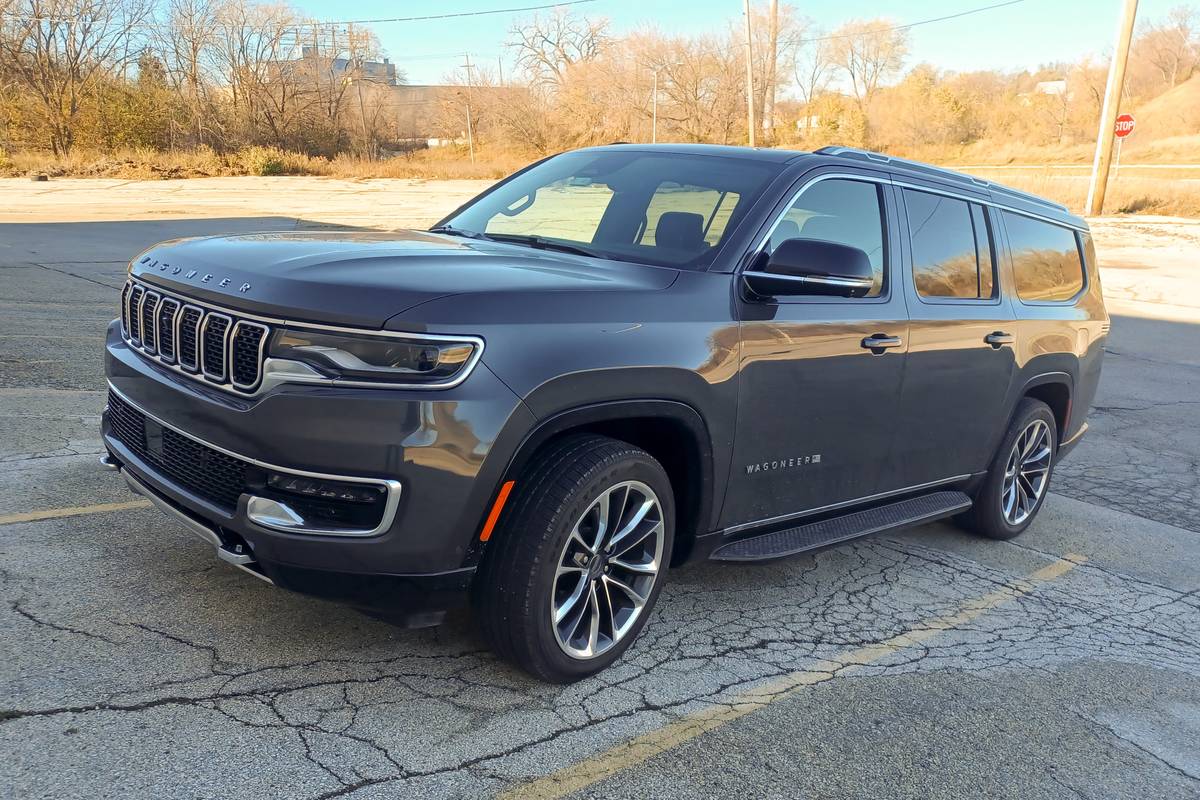2023 Jeep Wagoneer L: Real-World Road-Trip MPG


Jeep reintroduced the Wagoneer and Grand Wagoneer to its lineup for 2022, reimagining the brand’s giant retro SUVs for modern times, and for 2023, Jeep is offering shoppers even more power and space with a new twin-turbocharged six-cylinder engine and long-wheelbase L versions.
Related: 2023 Jeep Wagoneer, Grand Wagoneer Go Bigger With New L Versions
The 2023 Wagoneer L and Grand Wagoneer L are 12 inches longer than their regular-wheelbase siblings, resulting in loads more cargo room behind the third row than regular-wheelbase models offer, according to Jeep’s measurements.
While more cargo space is always a welcome addition to a family-oriented vehicle, the L versions have a less obvious addition, as well: a smaller engine. The Wagoneer L and Grand Wagoneer L come with a new twin-turbocharged 3.0-liter inline-six-cylinder engine instead of the 5.7-liter V-8 that’s standard on the 2023 Wagoneer (the six-cylinder is optional). Is it enough to move this big rig?
I took a Wagoneer L Series II 4×4 trim on a Thanksgiving road trip to pick up my family and a Christmas tree. How did the large three-row SUV handle the trip? It excelled in most places and disappointed in just one.
Room for More
First, we threw a lot at it in terms of people and stuff, using every inch of the added space. My test Wagoneer L was equipped with second- and third-row bench seats for a total seating capacity of eight people. I managed to haul four adults, three children (including two in space-hogging booster seats), a 6-foot Christmas tree and some luggage. Fitting it all was a challenging game of Tetris, but it worked and everyone was comfortable.
The L model has 42.1 cubic feet of space behind the third row by the brand’s measurements, up from the regular wheelbase’s 27.4 cubic feet. That’s also more than supersized rivals such as the Chevrolet Suburban and Lincoln Navigator L.
What’s more, the extra length provides a good deal of extra space without much penalty in terms of ride and handling. While the added length and larger turning circle make it a bit less maneuverable (especially when parking), the L model overall maintains the composure of its smaller sibling thanks to its naturally weighted and precise steering, plus its comfortable suspension tuning. It helped that my test vehicle was equipped with the optional Quadra-Lift air suspension system.
No V-8 Required
The added weight and length also didn’t slow it down; power wasn’t a problem. Jeep resurrected another old name for the L models’ new powertrain: The twin-turbo 3.0-liter six-cylinder is dubbed Hurricane. The standard-output version in the Wagoneer L makes 420 horsepower and 468 pounds-feet of torque. Compared with the 5.7-liter V-8 that’s standard in the regular-length Wagoneer, the Wagoneer L’s six-cylinder makes 28 more hp and 64 more pounds-feet of torque. The Grand Wagoneer L uses a high-output version of the engine rated at 510 hp and 500 pounds-feet of torque. This version of the six-cylinder requires premium fuel and makes 39 more hp and 45 more pounds-feet of torque than the 6.4-liter V-8 that’s standard in the regular-length Grand Wagoneer.
The standard-output six-cylinder engine in the Wagoneer L is amply up to the task of moving this giant Jeep with confidence. Acceleration was sharp off the line, with plenty of grunt for passing. Power delivery was smooth and timely thanks to a seamless eight-speed automatic transmission, and the pair was quiet and responsive — even when pushed.
The obvious problem with V-8s is their thirstiness, but even though the introduction of the twin-turbo six-cylinder hasn’t exactly solved that problem, it’s making strides. During my 326-mile trip of mostly highway driving, I averaged 16.2 mpg, short of the EPA-estimated 16/23/19 mpg city/highway/combined for 4WD models (2WD versions are rated 17/24/20 mpg). This is a modest improvement over the 15/20/17 mpg rating for the V-8-powered regular-length Wagoneer, though the Wagoneer L is also heavier.
Why wasn’t better fuel economy achievable during my drive? A trade-off. While the added length and space didn’t affect ride and handling that much, they certainly allowed me to load the truck with everything except a partridge in a pear tree. All that added weight, as well as the creature comforts used during the trip (the heated seats and steering wheel, for example), adds up and reduces efficiency.
While the Wagoneer L’s added space and polished powertrain exceeded expectations during my trip, its fuel economy fell short (this time).
More From Cars.com:
- Up Close With the 2023 Jeep Wagoneer L and Grand Wagoneer L
- 2022 Jeep Wagoneer and Grand Wagoneer Review: Big, Bold and Ready for a Challenge
- How Do Car Seats Fit in a 2022 Jeep Wagoneer?
- 2022 Jeep Wagoneer, Grand Wagoneer Will Offer Amazon Fire TV for Auto
- Find Your Next Car
Related Video:
Cars.com’s Editorial department is your source for automotive news and reviews. In line with Cars.com’s long-standing ethics policy, editors and reviewers don’t accept gifts or free trips from automakers. The Editorial department is independent of Cars.com’s advertising, sales and sponsored content departments.

News Editor Jennifer Geiger joined the automotive industry in 2003, much to the delight of her Corvette-obsessed dad. Jennifer is an expert reviewer, certified car-seat technician and mom of three. She wears a lot of hats — many of them while driving a minivan.
Featured stories




